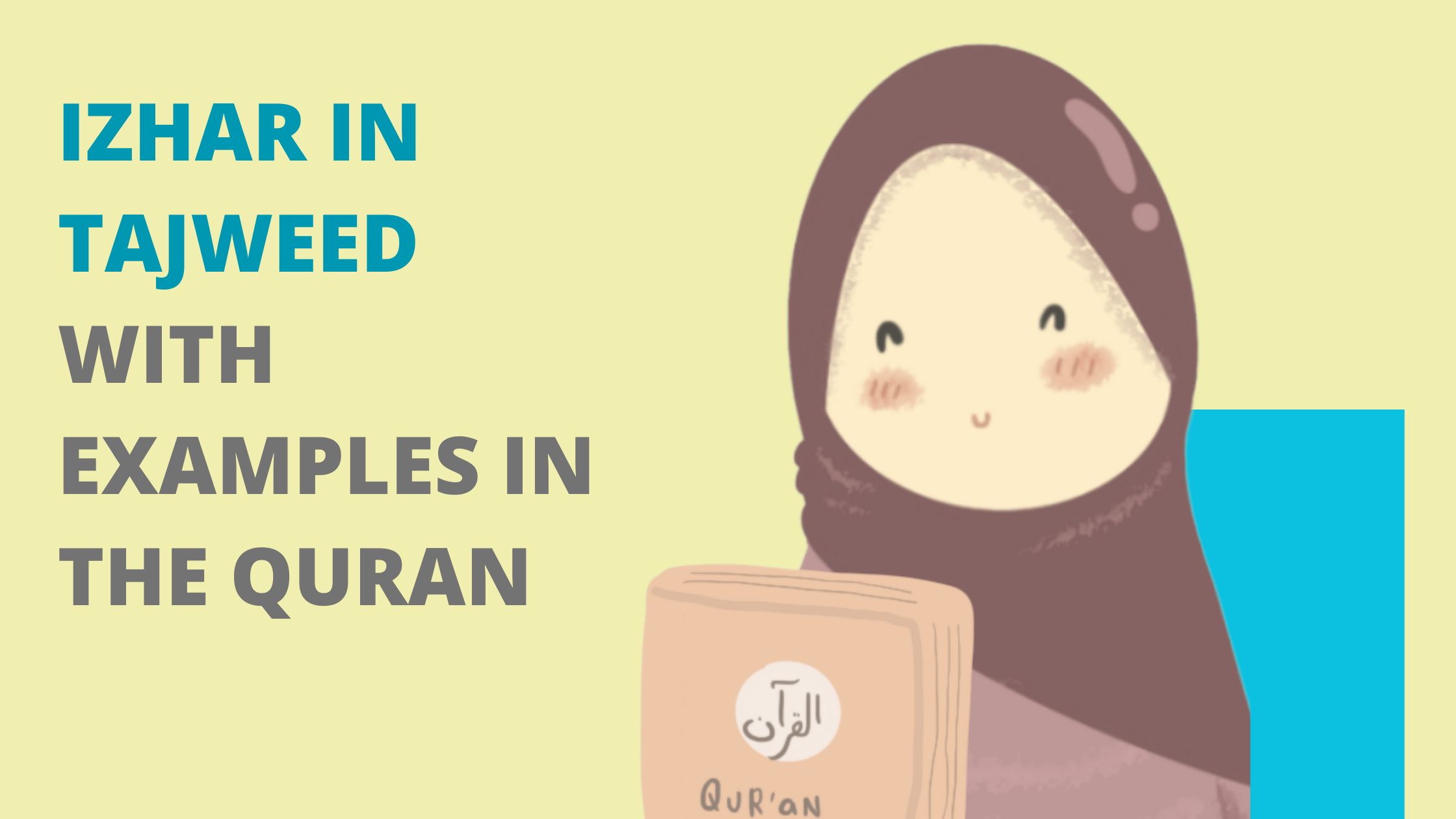In this comprehensive blog post, we will delve into the rule Izhar in Tajweed. Through this exploration, we will gain a deep understanding of what Izhar entails, including its significance in the recitation of the Quran.
We will unravel the various types of Izhar letters that can be found within the Quran and uncover the essential rules that govern their proper application.
By mastering the rule of Izhar, one can achieve the lofty goal of reciting the Quran with impeccable precision and captivating beauty. So, join us on this captivating journey as we embark on a detailed exploration of Izhar in Tajweed!
Table of Contents
What is Izhar in Tajweed?
Izhar in Tajweed refers to pronouncing a letter clearly and distinctly without pause, quiet, stress, or Ghunna. The term “Izhar” itself means “making something clear.”
This rule specifically applies when there is a Noon Sakinah or Tanween followed by one of the Izhar letters. In such cases, the Izhar letters are pronounced clearly and without any nasal sound (Ghunna).
The rule of Izhar in Tajweed is essential for accurately pronouncing the letters and maintaining the purity of the Quranic language. It assists reciters in clearly pronouncing each letter, ensuring correct recitation of the Quran.
Learn the proper pronunciation of Arabic letters with Tajweed to accurately recite the Quran. Join our Tajweed classes and improve your recitation skills today.
Izhar Letters in Tajweed
The Izhar letters in Tajweed are six: hamza (ء), haa (هـ), ain (ع), haa (ح), ghin (غ), and khaa (خ). When any of these six letters occur after a Noon Sakinah or Tanween, the rule of Izhar is applied.
This means that the letter is pronounced clearly without any nasal sound (Ghunnah) and the sound of the letter is fully manifested.
The term “Izhar” refers to the demonstration or appearance of the Noon Sakinah or Tanween when meeting these specific letters. These izhar letters are known as “halqi” because they originate from the throat.
Types of Izhar in Tajweed
Izhar is a rule in Tajweed that deals with the clear and distinct pronunciation of certain letters. There are three types of Izhar in Tajweed:
1. Izhar Shafawi:
This type is specific to the letter meem in its consonant state. All letters that appear in the Arabic language and come after the meem sakinah must be shown, except for the letters meem and baa when they combine with the meem sakinah.
2. Izhar Halqi:
This type includes the letters hamza, haa, ain, ghin, haa, and khaa. These letters must be shown clearly in pronunciation when they come after a Noon Sakinah or Tanween. They are called Izhar Halqi because they depend on the throat for pronunciation.
3. Izhar Mutlak:
This type focuses on clarifying the consonant “noon” when it is followed by the letters “waw” and “yaa”. The noon should be pronounced clearly to convey the correct meaning of the word.
It does not rely on any specific throat position but emphasizes the need to differentiate the pronunciation of noon from the letters waw and yaa to maintain the intended meaning of the word.
Mastering these rules will improve your skills in reciting the Quran and ensure accurate pronunciation based on Tajweed principles.
Examples of Izhar in Tajweed from the Quran
Izhar is one of the rules of Tajweed that involves pronouncing a letter clearly and distinctly without merging or assimilation. Here are some examples of Izhar in Tajweed from the Quran:
Examples of Izhar Halqi in Tajweed:
1. The first example of Izhar Halqi is the hamza with the noun sakinah in the word “ينأون”. This is an example in the Quran where the letter hamza appears with the consonant Noun in a single word.
2. The second example is the haa with a noun sakinah in the two words “مِنْ هَادٍ”. This demonstrates the Izhar Halqi rule with the letter haa followed by the noun sakinah.
3. The third example is the ain with a noun sakinah in the word “أَنْعَمَ”. This showcases the Izhar Halqi rule with the letter Ain and the following noun sakinah.
4. The fourth example of Izhar Halqi is the ghin with a noun sakinah in the word “فَسَيُنْغِضُونَ”. This is the instance in the Quran where the letter Ghin appears with the noun sakinah.
5. The fifth example is the Khaa with the noun sakinah in the word “الْمُنْخَنِقَةُ”. This demonstrates the Izhar Halqi rule with the letter khaa followed by the noun sakinah.
6. The sixth example is the ha with the noun sakinah in the word “وَانْحَرْ”. This shows the Izhar Halqi rule with the letter ha and the following noun sakinah.
Example of Izhar Shafawi:
The izhar shafawi rule applies to the meem sakinah when it meets certain letters. An example of this rule is found in the verse “لا تَرَى فِيهَا عِوَجًا وَلَا أَمْتًا”.
Example of Izhar Mutlak:
The izhar Mutlak rule occurs when Idgham is refused in a word. There are only four words in the Quran that follow this rule, such as the word “بُنْيَانٌ” in the verse “إِنَّ اللَّهَ يُحِبُّ الَّذِينَ يُقَاتِلُونَ فِي سَبِيلِهِ صَفًّا
Rules of Izhar in Tajweed
Izhar is a rule that plays a crucial role in reciting the Quran beautifully and accurately. In the following points, we will explore the various rules within Izhar and understand their significance.
1. Three Levels of Izhar Halqi:
Izhar halqi is divided into three levels based on the pronunciation from the throat – upper, middle, and lower levels. Each level corresponds to specific letters pronounced from different regions of the throat.
The upper throat area includes the letters haa and hamza, the middle throat area includes the letters ain and haa, and the lower throat area includes the letters ghain and khaa.
2. Reason for Implementing Izhar:
The reason for implementing the rule of Izhar is that it is difficult to pronounce the noun sakinah clearly on the tip of the tongue when followed by any of the six throat letters.
Therefore, it is necessary to pronounce the noun sakinah or tanween clearly at the throat letters. The condition for implementing Izhar is that there must be a letter after the noon sakinah.
3. Conditions for Implementing Izhar:
During Izhar, the reciter should utter the noun sakinah or tanween on a unit, and then proceed to pronounce the vowel letter al-Idhizhar without stopping or pausing on the nun or tanween.
4. Pronunciation during Izhar:
The reciter should not remain silent on the noun sakinah, nor cut it off from the following letter of Izhar.
The tip of the tongue collides with the gums of the upper folds without producing a noticeable increase in sound (ghunna).
5. Sound of Ghunna during Izhar:
It is important to note that the sound of the ghunna is very weak and almost imperceptible during Izhar.
The ghunna completely disappears in the original sound of the noun, and the letter following the noun sakinah or tanween should be pronounced without any affectation, silence, or separation between them.
To improve one’s understanding of Tajweed and its rules, it is recommended to enroll in online Tajweed Quran classes for kids taught by professional tutors at Bayan Al-Quran Academy.
Join Our Online Noorani Qaida Course and Empower Your Child’s Quranic Learning Journey at Bayan Al-Quran Academy
At Bayan Al-Quran Academy, we recognize the significance of offering high-quality Islamic education to children. That is why we provide an online learning program specifically designed for kids to learn the Noorani Qaida online, a crucial step in mastering Tajweed.
By enrolling your child with us, you are allowing them to learn from qualified instructors who specialize in teaching young learners. We foster a supportive atmosphere where students can freely ask questions and develop confidence in their recitation skills.
Investing in your child’s Quranic education is vital for their spiritual development. Join us at Bayan Al-Quran Academy today and give your child the tools to excel in reciting the Quran with proper Tajweed!
Conclusion
To conclude, Izhar is an essential concept in Tajweed that focuses on the clarity and pronunciation of letters. It involves the clear enunciation of certain letters without any nasal or voiced sound.
There are three types of Izhar: Izhar Shafawi, Izhar Mutlak, and Izhar Halqi, each with its own set of rules and examples found in the Quran. Following these rules ensures accurate recitation of the Quran and helps to convey its intended meanings effectively.
At Bayan Al-Quran Academy, we offer online courses for children to learn Noorani Qaida, which provides a strong foundation in Tajweed principles such as Izhar. Join us today to embark on a rewarding journey towards perfecting your recitation and connecting with the divine words of Allah (SWT).















